| Listing 1 - 10 of 11 | << page >> |
Sort by
|
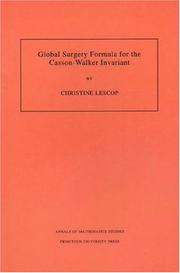
ISBN: 0691021333 1400865158 9781400865154 9780691021331 0691021325 9780691021324 Year: 2014 Volume: 140 Publisher: Princeton, NJ
Abstract | Keywords | Export | Availability | Bookmark
 Loading...
Loading...Choose an application
- Reference Manager
- EndNote
- RefWorks (Direct export to RefWorks)
This book presents a new result in 3-dimensional topology. It is well known that any closed oriented 3-manifold can be obtained by surgery on a framed link in S 3. In Global Surgery Formula for the Casson-Walker Invariant, a function F of framed links in S 3 is described, and it is proven that F consistently defines an invariant, lamda (l), of closed oriented 3-manifolds. l is then expressed in terms of previously known invariants of 3-manifolds. For integral homology spheres, l is the invariant introduced by Casson in 1985, which allowed him to solve old and famous questions in 3-dimensional topology. l becomes simpler as the first Betti number increases. As an explicit function of Alexander polynomials and surgery coefficients of framed links, the function F extends in a natural way to framed links in rational homology spheres. It is proven that F describes the variation of l under any surgery starting from a rational homology sphere. Thus F yields a global surgery formula for the Casson invariant.
Chirurgie (Topologie) --- Drie-menigvuldigheden (Topologie) --- Heelkunde (Topologie) --- Surgery (Topology) --- Three-manifolds (Topology) --- Trois-variétés (Topologie) --- 3-manifolds (Topology) --- Manifolds, Three dimensional (Topology) --- Three-dimensional manifolds (Topology) --- Low-dimensional topology --- Topological manifolds --- Differential topology --- Homotopy equivalences --- Manifolds (Mathematics) --- Topology --- 515.16 --- 515.16 Topology of manifolds --- Topology of manifolds --- 3-manifold. --- Addition. --- Alexander polynomial. --- Ambient isotopy. --- Betti number. --- Casson invariant. --- Change of basis. --- Change of variables. --- Cobordism. --- Coefficient. --- Combination. --- Combinatorics. --- Computation. --- Conjugacy class. --- Connected component (graph theory). --- Connected space. --- Connected sum. --- Cup product. --- Determinant. --- Diagram (category theory). --- Disk (mathematics). --- Empty set. --- Exterior (topology). --- Fiber bundle. --- Fibration. --- Function (mathematics). --- Fundamental group. --- Homeomorphism. --- Homology (mathematics). --- Homology sphere. --- Homotopy sphere. --- Indeterminate (variable). --- Integer. --- Klein bottle. --- Knot theory. --- Manifold. --- Morphism. --- Notation. --- Orientability. --- Permutation. --- Polynomial. --- Prime number. --- Projective plane. --- Scientific notation. --- Seifert surface. --- Sequence. --- Summation. --- Symmetrization. --- Taylor series. --- Theorem. --- Topology. --- Tubular neighborhood. --- Unlink.
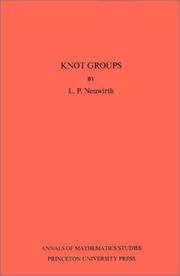
ISBN: 0691079919 1400882036 9780691079912 Year: 1965 Volume: 56 Publisher: Princeton, N. J.
Abstract | Keywords | Export | Availability | Bookmark
 Loading...
Loading...Choose an application
- Reference Manager
- EndNote
- RefWorks (Direct export to RefWorks)
The description for this book, Knot Groups. Annals of Mathematics Studies. (AM-56), Volume 56, will be forthcoming.
Topology --- 512 --- Algebra --- 512 Algebra --- Knot theory. --- Knots (Topology) --- Low-dimensional topology --- Abelian group. --- Alexander duality. --- Alexander polynomial. --- Algebraic theory. --- Algorithm. --- Analytic continuation. --- Associative property. --- Automorphism. --- Axiom. --- Bijection. --- Binary relation. --- Calculation. --- Central series. --- Characterization (mathematics). --- Cobordism. --- Coefficient. --- Cohomology. --- Combinatorics. --- Commutator subgroup. --- Complete theory. --- Computation. --- Conjugacy class. --- Conjugate element (field theory). --- Connected space. --- Connectedness. --- Coprime integers. --- Coset. --- Covering space. --- Curve. --- Cyclic group. --- Dehn's lemma. --- Determinant. --- Diagonalization. --- Diagram (category theory). --- Dimension. --- Direct product. --- Equivalence class. --- Equivalence relation. --- Euclidean space. --- Euler characteristic. --- Existential quantification. --- Fiber bundle. --- Finite group. --- Finitely generated module. --- Frattini subgroup. --- Free abelian group. --- Fundamental group. --- Geometry. --- Group ring. --- Group theory. --- Group with operators. --- Hausdorff space. --- Homeomorphism. --- Homology (mathematics). --- Homomorphism. --- Homotopy group. --- Homotopy. --- Identity matrix. --- Inner automorphism. --- Interior (topology). --- Intersection number (graph theory). --- Knot group. --- Linear combination. --- Manifold. --- Mathematical induction. --- Monomorphism. --- Morphism. --- Morse theory. --- Natural transformation. --- Non-abelian group. --- Normal subgroup. --- Orientability. --- Permutation. --- Polynomial. --- Presentation of a group. --- Principal ideal domain. --- Principal ideal. --- Root of unity. --- Semigroup. --- Simplicial complex. --- Simply connected space. --- Special case. --- Square matrix. --- Subgroup. --- Subset. --- Summation. --- Theorem. --- Three-dimensional space (mathematics). --- Topological space. --- Topology. --- Torus knot. --- Transfinite number. --- Trefoil knot. --- Trichotomy (mathematics). --- Trivial group. --- Triviality (mathematics). --- Two-dimensional space. --- Unit vector. --- Wreath product.
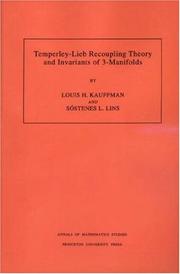
ISBN: 0691036411 0691036403 1400882532 9780691036403 9780691036410 Year: 1994 Volume: 134 Publisher: Princeton, N.J. Princeton University Press
Abstract | Keywords | Export | Availability | Bookmark
 Loading...
Loading...Choose an application
- Reference Manager
- EndNote
- RefWorks (Direct export to RefWorks)
This book offers a self-contained account of the 3-manifold invariants arising from the original Jones polynomial. These are the Witten-Reshetikhin-Turaev and the Turaev-Viro invariants. Starting from the Kauffman bracket model for the Jones polynomial and the diagrammatic Temperley-Lieb algebra, higher-order polynomial invariants of links are constructed and combined to form the 3-manifold invariants. The methods in this book are based on a recoupling theory for the Temperley-Lieb algebra. This recoupling theory is a q-deformation of the SU(2) spin networks of Roger Penrose. The recoupling theory is developed in a purely combinatorial and elementary manner. Calculations are based on a reformulation of the Kirillov-Reshetikhin shadow world, leading to expressions for all the invariants in terms of state summations on 2-cell complexes. Extensive tables of the invariants are included. Manifolds in these tables are recognized by surgery presentations and by means of 3-gems (graph encoded 3-manifolds) in an approach pioneered by Sostenes Lins. The appendices include information about gems, examples of distinct manifolds with the same invariants, and applications to the Turaev-Viro invariant and to the Crane-Yetter invariant of 4-manifolds.
Drie-menigvuldigheden (Topologie) --- Knopentheorie --- Knot theory --- Noeuds [Theorie des ] --- Three-manifolds (Topology) --- Trois-variétés (Topologie) --- Knot theory. --- Algebraic topology --- Invariants --- Mathematics --- Invariants (Mathematics) --- Invariants. --- 3-manifolds (Topology) --- Manifolds, Three dimensional (Topology) --- Three-dimensional manifolds (Topology) --- Low-dimensional topology --- Topological manifolds --- Knots (Topology) --- 3-manifold. --- Addition. --- Algorithm. --- Ambient isotopy. --- Axiom. --- Backslash. --- Barycentric subdivision. --- Bijection. --- Bipartite graph. --- Borromean rings. --- Boundary parallel. --- Bracket polynomial. --- Calculation. --- Canonical form. --- Cartesian product. --- Cobordism. --- Coefficient. --- Combination. --- Commutator. --- Complex conjugate. --- Computation. --- Connected component (graph theory). --- Connected sum. --- Cubic graph. --- Diagram (category theory). --- Dimension. --- Disjoint sets. --- Disjoint union. --- Elaboration. --- Embedding. --- Equation. --- Equivalence class. --- Explicit formula. --- Explicit formulae (L-function). --- Factorial. --- Fundamental group. --- Graph (discrete mathematics). --- Graph embedding. --- Handlebody. --- Homeomorphism. --- Homology (mathematics). --- Identity element. --- Intersection form (4-manifold). --- Inverse function. --- Jones polynomial. --- Kirby calculus. --- Line segment. --- Linear independence. --- Matching (graph theory). --- Mathematical physics. --- Mathematical proof. --- Mathematics. --- Maxima and minima. --- Monograph. --- Natural number. --- Network theory. --- Notation. --- Numerical analysis. --- Orientability. --- Orthogonality. --- Pairing. --- Pairwise. --- Parametrization. --- Parity (mathematics). --- Partition function (mathematics). --- Permutation. --- Poincaré conjecture. --- Polyhedron. --- Quantum group. --- Quantum invariant. --- Recoupling. --- Recursion. --- Reidemeister move. --- Result. --- Roger Penrose. --- Root of unity. --- Scientific notation. --- Sequence. --- Significant figures. --- Simultaneous equations. --- Smoothing. --- Special case. --- Sphere. --- Spin network. --- Summation. --- Symmetric group. --- Tetrahedron. --- The Geometry Center. --- Theorem. --- Theory. --- Three-dimensional space (mathematics). --- Time complexity. --- Tubular neighborhood. --- Two-dimensional space. --- Vector field. --- Vector space. --- Vertex (graph theory). --- Winding number. --- Writhe.
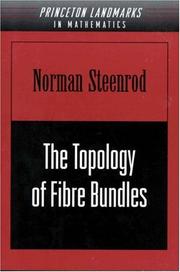
ISBN: 0691080550 0691005486 1400883873 9780691080550 Year: 1951 Volume: 14 Publisher: Princeton (N.J.): Princeton university press
Abstract | Keywords | Export | Availability | Bookmark
 Loading...
Loading...Choose an application
- Reference Manager
- EndNote
- RefWorks (Direct export to RefWorks)
Fibre bundles, now an integral part of differential geometry, are also of great importance in modern physics--such as in gauge theory. This book, a succinct introduction to the subject by renown mathematician Norman Steenrod, was the first to present the subject systematically. It begins with a general introduction to bundles, including such topics as differentiable manifolds and covering spaces. The author then provides brief surveys of advanced topics, such as homotopy theory and cohomology theory, before using them to study further properties of fibre bundles. The result is a classic and timeless work of great utility that will appeal to serious mathematicians and theoretical physicists alike.
#WWIS:d.d. Prof. L. Bouckaert/ALTO --- 515.1 --- 515.1 Topology --- Topology --- Topology. --- Analysis situs --- Position analysis --- Rubber-sheet geometry --- Geometry --- Polyhedra --- Set theory --- Algebras, Linear --- Algebraic topology. --- Associated bundle. --- Associative algebra. --- Associative property. --- Atlas (topology). --- Automorphism. --- Axiomatic system. --- Barycentric subdivision. --- Bilinear map. --- Bundle map. --- Classification theorem. --- Coefficient. --- Cohomology ring. --- Cohomology. --- Conjugacy class. --- Connected component (graph theory). --- Connected space. --- Coordinate system. --- Coset. --- Cup product. --- Cyclic group. --- Determinant. --- Differentiable manifold. --- Differential structure. --- Dimension (vector space). --- Direct product. --- Division algebra. --- Equivalence class. --- Equivalence relation. --- Euler number. --- Existence theorem. --- Existential quantification. --- Factorization. --- Fiber bundle. --- Frenet–Serret formulas. --- Gram–Schmidt process. --- Group theory. --- Homeomorphism. --- Homology (mathematics). --- Homomorphism. --- Homotopy group. --- Homotopy. --- Hopf theorem. --- Hurewicz theorem. --- Identity element. --- Inclusion map. --- Inner automorphism. --- Invariant subspace. --- Invertible matrix. --- Jacobian matrix and determinant. --- Klein bottle. --- Lattice of subgroups. --- Lie group. --- Line element. --- Line segment. --- Linear map. --- Linear space (geometry). --- Linear subspace. --- Manifold. --- Mapping cylinder. --- Metric tensor. --- N-sphere. --- Natural topology. --- Octonion. --- Open set. --- Orientability. --- Orthogonal group. --- Orthogonalization. --- Permutation. --- Principal bundle. --- Product topology. --- Quadratic form. --- Quaternion. --- Retract. --- Separable space. --- Set theory. --- Simplicial complex. --- Special case. --- Stiefel manifold. --- Subalgebra. --- Subbase. --- Subgroup. --- Subset. --- Symmetric tensor. --- Tangent bundle. --- Tangent space. --- Tangent vector. --- Tensor field. --- Tensor. --- Theorem. --- Tietze extension theorem. --- Topological group. --- Topological space. --- Transitive relation. --- Transpose. --- Union (set theory). --- Unit sphere. --- Universal bundle. --- Vector field.
Book
ISBN: 0691080275 069162612X 0691652449 140087453X Year: 2015 Publisher: Princeton, NJ : Princeton University Press,
Abstract | Keywords | Export | Availability | Bookmark
 Loading...
Loading...Choose an application
- Reference Manager
- EndNote
- RefWorks (Direct export to RefWorks)
The theory of Riemann surfaces has a geometric and an analytic part. The former deals with the axiomatic definition of a Riemann surface, methods of construction, topological equivalence, and conformal mappings of one Riemann surface on another. The analytic part is concerned with the existence and properties of functions that have a special character connected with the conformal structure, for instance: subharmonic, harmonic, and analytic functions.Originally published in 1960.The Princeton Legacy Library uses the latest print-on-demand technology to again make available previously out-of-print books from the distinguished backlist of Princeton University Press. These editions preserve the original texts of these important books while presenting them in durable paperback and hardcover editions. The goal of the Princeton Legacy Library is to vastly increase access to the rich scholarly heritage found in the thousands of books published by Princeton University Press since its founding in 1905.
515.16 --- 515.16 Topology of manifolds --- Topology of manifolds --- Riemann surfaces. --- Topology. --- Analysis situs --- Position analysis --- Rubber-sheet geometry --- Geometry --- Polyhedra --- Set theory --- Algebras, Linear --- Surfaces, Riemann --- Functions --- Analytic function. --- Axiom of choice. --- Basis (linear algebra). --- Betti number. --- Big O notation. --- Bijection. --- Bilinear form. --- Bolzano–Weierstrass theorem. --- Boundary (topology). --- Boundary value problem. --- Bounded set (topological vector space). --- Branch point. --- Canonical basis. --- Cauchy sequence. --- Cauchy's integral formula. --- Characterization (mathematics). --- Coefficient. --- Commutator subgroup. --- Compact space. --- Compactification (mathematics). --- Conformal map. --- Connected space. --- Connectedness. --- Continuous function (set theory). --- Continuous function. --- Coset. --- Cross-cap. --- Dirichlet integral. --- Disjoint union. --- Elementary function. --- Elliptic surface. --- Exact differential. --- Existence theorem. --- Existential quantification. --- Extremal length. --- Family of sets. --- Finite intersection property. --- Finitely generated abelian group. --- Free group. --- Function (mathematics). --- Fundamental group. --- Green's function. --- Harmonic differential. --- Harmonic function. --- Harmonic measure. --- Heine–Borel theorem. --- Homeomorphism. --- Homology (mathematics). --- Ideal point. --- Infimum and supremum. --- Isolated point. --- Isolated singularity. --- Jordan curve theorem. --- Lebesgue integration. --- Limit point. --- Line segment. --- Linear independence. --- Linear map. --- Maximal set. --- Maximum principle. --- Meromorphic function. --- Metric space. --- Normal operator. --- Normal subgroup. --- Open set. --- Orientability. --- Orthogonal complement. --- Partition of unity. --- Point at infinity. --- Polyhedron. --- Positive harmonic function. --- Principal value. --- Projection (linear algebra). --- Projection (mathematics). --- Removable singularity. --- Riemann mapping theorem. --- Riemann surface. --- Semi-continuity. --- Sign (mathematics). --- Simplicial homology. --- Simply connected space. --- Singular homology. --- Skew-symmetric matrix. --- Special case. --- Subgroup. --- Subset. --- Summation. --- Support (mathematics). --- Taylor series. --- Theorem. --- Topological space. --- Triangle inequality. --- Uniform continuity. --- Uniformization theorem. --- Unit disk. --- Upper and lower bounds. --- Upper half-plane. --- Weyl's lemma (Laplace equation). --- Zorn's lemma.

ISBN: 0691081492 1400881420 9780691081496 Year: 1975 Volume: 82 Publisher: Princeton, N. J.
Abstract | Keywords | Export | Availability | Bookmark
 Loading...
Loading...Choose an application
- Reference Manager
- EndNote
- RefWorks (Direct export to RefWorks)
The central theme of this study is Artin's braid group and the many ways that the notion of a braid has proved to be important in low-dimensional topology.In Chapter 1 the author is concerned with the concept of a braid as a group of motions of points in a manifold. She studies structural and algebraic properties of the braid groups of two manifolds, and derives systems of defining relations for the braid groups of the plane and sphere. In Chapter 2 she focuses on the connections between the classical braid group and the classical knot problem. After reviewing basic results she proceeds to an exploration of some possible implications of the Garside and Markov theorems.Chapter 3 offers discussion of matrix representations of the free group and of subgroups of the automorphism group of the free group. These ideas come to a focus in the difficult open question of whether Burau's matrix representation of the braid group is faithful. Chapter 4 is a broad view of recent results on the connections between braid groups and mapping class groups of surfaces. Chapter 5 contains a brief discussion of the theory of "plats." Research problems are included in an appendix.
Braid theory --- Braids, Theory of --- Theory of braids --- Braid theory. --- Algebraic topology --- Knot theory --- Representations of groups --- 512.54 --- Group representation (Mathematics) --- Groups, Representation theory of --- Group theory --- Knots (Topology) --- Low-dimensional topology --- 512.54 Groups. Group theory --- Groups. Group theory --- Knot theory. --- Representations of groups. --- Addition. --- Alexander polynomial. --- Algebraic structure. --- Automorphism. --- Ball (mathematics). --- Bijection. --- Braid group. --- Branched covering. --- Burau representation. --- Calculation. --- Cartesian coordinate system. --- Characterization (mathematics). --- Coefficient. --- Combinatorial group theory. --- Commutative property. --- Commutator subgroup. --- Configuration space. --- Conjugacy class. --- Corollary. --- Covering space. --- Dehn twist. --- Determinant. --- Diagram (category theory). --- Dimension. --- Disjoint union. --- Double coset. --- Eigenvalues and eigenvectors. --- Enumeration. --- Equation. --- Equivalence class. --- Exact sequence. --- Existential quantification. --- Faithful representation. --- Finite set. --- Free abelian group. --- Free group. --- Fundamental group. --- Geometry. --- Group (mathematics). --- Group ring. --- Groupoid. --- Handlebody. --- Heegaard splitting. --- Homeomorphism. --- Homomorphism. --- Homotopy group. --- Homotopy. --- Identity element. --- Identity matrix. --- Inclusion map. --- Initial point. --- Integer matrix. --- Integer. --- Knot polynomial. --- Lens space. --- Line segment. --- Line–line intersection. --- Link group. --- Low-dimensional topology. --- Mapping class group. --- Mathematical induction. --- Mathematics. --- Matrix group. --- Matrix representation. --- Monograph. --- Morphism. --- Natural transformation. --- Normal matrix. --- Notation. --- Orientability. --- Parity (mathematics). --- Permutation. --- Piecewise linear. --- Pointwise. --- Polynomial. --- Prime knot. --- Projection (mathematics). --- Proportionality (mathematics). --- Quotient group. --- Requirement. --- Rewriting. --- Riemann surface. --- Semigroup. --- Sequence. --- Special case. --- Subgroup. --- Submanifold. --- Subset. --- Symmetric group. --- Theorem. --- Theory. --- Topology. --- Trefoil knot. --- Two-dimensional space. --- Unimodular matrix. --- Unit vector. --- Variable (mathematics). --- Word problem (mathematics). --- Topologie algébrique
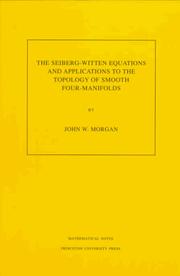
ISBN: 1400865166 9781400865161 9780691025971 0691025975 9780691025971 Year: 2014 Publisher: Princeton, NJ
Abstract | Keywords | Export | Availability | Bookmark
 Loading...
Loading...Choose an application
- Reference Manager
- EndNote
- RefWorks (Direct export to RefWorks)
The recent introduction of the Seiberg-Witten invariants of smooth four-manifolds has revolutionized the study of those manifolds. The invariants are gauge-theoretic in nature and are close cousins of the much-studied SU(2)-invariants defined over fifteen years ago by Donaldson. On a practical level, the new invariants have proved to be more powerful and have led to a vast generalization of earlier results. This book is an introduction to the Seiberg-Witten invariants. The work begins with a review of the classical material on Spin c structures and their associated Dirac operators. Next comes a discussion of the Seiberg-Witten equations, which is set in the context of nonlinear elliptic operators on an appropriate infinite dimensional space of configurations. It is demonstrated that the space of solutions to these equations, called the Seiberg-Witten moduli space, is finite dimensional, and its dimension is then computed. In contrast to the SU(2)-case, the Seiberg-Witten moduli spaces are shown to be compact. The Seiberg-Witten invariant is then essentially the homology class in the space of configurations represented by the Seiberg-Witten moduli space. The last chapter gives a flavor for the applications of these new invariants by computing the invariants for most Kahler surfaces and then deriving some basic toological consequences for these surfaces.
Four-manifolds (Topology) --- Seiberg-Witten invariants. --- Mathematical physics. --- Physical mathematics --- Physics --- Invariants --- 4-dimensional manifolds (Topology) --- 4-manifolds (Topology) --- Four dimensional manifolds (Topology) --- Manifolds, Four dimensional --- Low-dimensional topology --- Topological manifolds --- Mathematics --- Affine space. --- Affine transformation. --- Algebra bundle. --- Algebraic surface. --- Almost complex manifold. --- Automorphism. --- Banach space. --- Clifford algebra. --- Cohomology. --- Cokernel. --- Complex dimension. --- Complex manifold. --- Complex plane. --- Complex projective space. --- Complex vector bundle. --- Complexification (Lie group). --- Computation. --- Configuration space. --- Conjugate transpose. --- Covariant derivative. --- Curvature form. --- Curvature. --- Differentiable manifold. --- Differential topology. --- Dimension (vector space). --- Dirac equation. --- Dirac operator. --- Division algebra. --- Donaldson theory. --- Duality (mathematics). --- Eigenvalues and eigenvectors. --- Elliptic operator. --- Elliptic surface. --- Equation. --- Fiber bundle. --- Frenet–Serret formulas. --- Gauge fixing. --- Gauge theory. --- Gaussian curvature. --- Geometry. --- Group homomorphism. --- Hilbert space. --- Hodge index theorem. --- Homology (mathematics). --- Homotopy. --- Identity (mathematics). --- Implicit function theorem. --- Intersection form (4-manifold). --- Inverse function theorem. --- Isomorphism class. --- K3 surface. --- Kähler manifold. --- Levi-Civita connection. --- Lie algebra. --- Line bundle. --- Linear map. --- Linear space (geometry). --- Linearization. --- Manifold. --- Mathematical induction. --- Moduli space. --- Multiplication theorem. --- Neighbourhood (mathematics). --- One-form. --- Open set. --- Orientability. --- Orthonormal basis. --- Parameter space. --- Parametric equation. --- Parity (mathematics). --- Partial derivative. --- Principal bundle. --- Projection (linear algebra). --- Pullback (category theory). --- Quadratic form. --- Quaternion algebra. --- Quotient space (topology). --- Riemann surface. --- Riemannian manifold. --- Sard's theorem. --- Sign (mathematics). --- Sobolev space. --- Spin group. --- Spin representation. --- Spin structure. --- Spinor field. --- Subgroup. --- Submanifold. --- Surjective function. --- Symplectic geometry. --- Symplectic manifold. --- Tangent bundle. --- Tangent space. --- Tensor product. --- Theorem. --- Three-dimensional space (mathematics). --- Trace (linear algebra). --- Transversality (mathematics). --- Two-form. --- Zariski tangent space.
Book
ISBN: 0691653682 1400875668 9781400875665 9780691079479 9780691627748 0691627746 9780691627748 Year: 2015 Publisher: Princeton, NJ
Abstract | Keywords | Export | Availability | Bookmark
 Loading...
Loading...Choose an application
- Reference Manager
- EndNote
- RefWorks (Direct export to RefWorks)
Book 4 in the Princeton Mathematical Series.Originally published in 1941.The Princeton Legacy Library uses the latest print-on-demand technology to again make available previously out-of-print books from the distinguished backlist of Princeton University Press. These editions preserve the original texts of these important books while presenting them in durable paperback and hardcover editions. The goal of the Princeton Legacy Library is to vastly increase access to the rich scholarly heritage found in the thousands of books published by Princeton University Press since its founding in 1905.
Topology. --- Analysis situs --- Position analysis --- Rubber-sheet geometry --- Geometry --- Polyhedra --- Set theory --- Algebras, Linear --- Abelian group. --- Additive group. --- Adjunction (field theory). --- Algebraic connectivity. --- Algebraic number. --- Annihilator (ring theory). --- Automorphism. --- Barycentric coordinate system. --- Barycentric subdivision. --- Big O notation. --- Boundary (topology). --- Cantor set. --- Cardinal number. --- Cartesian coordinate system. --- Cauchy sequence. --- Character group. --- Circumference. --- Cohomology. --- Combinatorics. --- Compact space. --- Complete metric space. --- Complex number. --- Computation. --- Continuous function (set theory). --- Continuous function. --- Contractible space. --- Cyclic group. --- Dense set. --- Diameter. --- Dimension (vector space). --- Dimension function. --- Dimension theory (algebra). --- Dimension. --- Dimensional analysis. --- Discrete group. --- Disjoint sets. --- Domain of a function. --- Equation. --- Euclidean space. --- Existential quantification. --- Exponentiation. --- Function (mathematics). --- Function space. --- Fundamental theorem. --- Geometry. --- Group theory. --- Hausdorff dimension. --- Hausdorff space. --- Hilbert cube. --- Hilbert space. --- Homeomorphism. --- Homology (mathematics). --- Homomorphism. --- Homotopy. --- Hyperplane. --- Integer. --- Interior (topology). --- Invariance of domain. --- Inverse system. --- Linear space (geometry). --- Linear subspace. --- Lp space. --- Mathematical induction. --- Mathematics. --- Metric space. --- Multiplicative group. --- N-sphere. --- Natural number. --- Natural transformation. --- Ordinal number. --- Orientability. --- Parity (mathematics). --- Partial function. --- Partially ordered set. --- Point (geometry). --- Polytope. --- Projection (linear algebra). --- Samuel Eilenberg. --- Separable space. --- Separated sets. --- Set (mathematics). --- Set theory. --- Sign (mathematics). --- Simplex. --- Special case. --- Subgroup. --- Subsequence. --- Subset. --- Summation. --- Theorem. --- Three-dimensional space (mathematics). --- Topological group. --- Topological property. --- Topological space. --- Transfinite. --- Transitive relation. --- Unit sphere. --- Upper and lower bounds. --- Variable (mathematics).
Book
ISBN: 0691185891 Year: 2020 Publisher: Princeton, New Jersey ; Oxford : Princeton University Press,
Abstract | Keywords | Export | Availability | Bookmark
 Loading...
Loading...Choose an application
- Reference Manager
- EndNote
- RefWorks (Direct export to RefWorks)
William Thurston (1946–2012) was one of the great mathematicians of the twentieth century. He was a visionary whose extraordinary ideas revolutionized a broad range of mathematical fields, from foliations, contact structures, and Teichmüller theory to automorphisms of surfaces, hyperbolic geometry, geometrization of 3-manifolds, geometric group theory, and rational maps. In addition, he discovered connections between disciplines that led to astonishing breakthroughs in mathematical understanding as well as the creation of entirely new fields. His far-reaching questions and conjectures led to enormous progress by other researchers. What's Next? brings together many of today's leading mathematicians to describe recent advances and future directions inspired by Thurston's transformative ideas.Including valuable insights from his colleagues and former students, What's Next? discusses Thurston's fundamental contributions to topology, geometry, and dynamical systems and includes many deep and original contributions to the field. This incisive and wide-ranging book also explores how he introduced new ways of thinking about and doing mathematics, innovations that have had a profound and lasting impact on the mathematical community as a whole.
Dynamics. --- Geometry. --- Topology. --- MATHEMATICS / General. --- Analysis situs --- Position analysis --- Rubber-sheet geometry --- Geometry --- Polyhedra --- Set theory --- Algebras, Linear --- Mathematics --- Euclid's Elements --- Dynamical systems --- Kinetics --- Mechanics, Analytic --- Force and energy --- Mechanics --- Physics --- Statics --- Thurston, William P., --- Thurston, W. P. --- Arbitrarily large. --- Asymptotic expansion. --- Automorphism. --- Big O notation. --- Braid group. --- Branch point. --- Central series. --- Character variety. --- Characterization (mathematics). --- Cohomology operation. --- Cohomology. --- Commutative property. --- Conjecture. --- Conjugacy class. --- Convex hull. --- Covering space. --- Coxeter group. --- Curvature. --- Dehn's lemma. --- Diagram (category theory). --- Disjoint union. --- Eigenfunction. --- Endomorphism. --- Epimorphism. --- Equivalence class. --- Equivalence relation. --- Euclidean space. --- Extreme point. --- Faithful representation. --- Fiber bundle. --- Free group. --- Free product. --- Fundamental group. --- Geometrization conjecture. --- HNN extension. --- Haar measure. --- Homeomorphism. --- Homotopy. --- Hyperbolic 3-manifold. --- Hyperbolic geometry. --- Hyperbolic manifold. --- Hyperbolic space. --- Hypercube. --- I0. --- Inclusion map. --- Incompressible surface. --- JSJ decomposition. --- Jordan curve theorem. --- Julia set. --- Klein bottle. --- Kleinian group. --- Lebesgue measure. --- Leech lattice. --- Limit point. --- Lyapunov exponent. --- Mahler measure. --- Manifold decomposition. --- Mapping cylinder. --- Marriage theorem. --- Maxima and minima. --- Moduli space. --- Möbius strip. --- Möbius transformation. --- Natural topology. --- Non-Euclidean geometry. --- Non-positive curvature. --- Normal subgroup. --- Open set. --- Orientability. --- Pair of pants (mathematics). --- Perfect group. --- Pleated surface. --- Polynomial. --- Preorder. --- Probability measure. --- Pullback (category theory). --- Pullback (differential geometry). --- Quadric. --- Quasi-isometry. --- Quasiconvex function. --- Rectangle. --- Riemann surface. --- Riemannian manifold. --- Saddle point. --- Sectional curvature. --- Sign (mathematics). --- Simple algebra. --- Simply connected space. --- Special case. --- Subgroup. --- Subset. --- Symplectic geometry. --- Theorem. --- Total order. --- Unit disk. --- Unit sphere. --- Upper and lower bounds. --- Vector bundle.
Book
ISBN: 0691080771 1322886709 0691621365 1400871239 0691648026 9780691080772 Year: 1976 Publisher: Princeton, N. J.
Abstract | Keywords | Export | Availability | Bookmark
 Loading...
Loading...Choose an application
- Reference Manager
- EndNote
- RefWorks (Direct export to RefWorks)
Global analysis describes diverse yet interrelated research areas in analysis and algebraic geometry, particularly those in which Kunihiko Kodaira made his most outstanding contributions to mathematics. The eminent contributors to this volume, from Japan, the United States, and Europe, have prepared original research papers that illustrate the progress and direction of current research in complex variables and algebraic and differential geometry. The authors investigate, among other topics, complex manifolds, vector bundles, curved 4-dimensional space, and holomorphic mappings. Bibliographies facilitate further reading in the development of the various studies.Originally published in 1970.The Princeton Legacy Library uses the latest print-on-demand technology to again make available previously out-of-print books from the distinguished backlist of Princeton University Press. These editions preserve the original texts of these important books while presenting them in durable paperback and hardcover editions. The goal of the Princeton Legacy Library is to vastly increase access to the rich scholarly heritage found in the thousands of books published by Princeton University Press since its founding in 1905.
Differential geometry. Global analysis --- Global analysis (Mathematics) --- Calculus of variations --- Differentiable manifolds --- 517.97 --- Analysis, Global (Mathematics) --- Differential topology --- Functions of complex variables --- Geometry, Algebraic --- Calculus of variations. Mathematical theory of control --- Differentiable manifolds. --- Calculus of variations. --- Global analysis (Mathematics). --- 517.97 Calculus of variations. Mathematical theory of control --- Algebraic topology --- 514.7 --- -Calculus of variations --- #TCPW W3.0 --- #TCPW W3.2 --- #WWIS:MEET --- Differential manifolds --- Manifolds (Mathematics) --- Isoperimetrical problems --- Variations, Calculus of --- Maxima and minima --- Differential geometry. Algebraic and analytic methods in geometry --- 514.7 Differential geometry. Algebraic and analytic methods in geometry --- Addresses, essays, lectures --- Functional analysis --- Geometry --- Algebra homomorphism. --- Algebraic space. --- Associated graded ring. --- Automorphism. --- Betti number. --- Bilinear form. --- Canonical basis. --- Canonical bundle. --- Closed immersion. --- Codimension. --- Coefficient. --- Cohomology. --- Cokernel. --- Complete intersection. --- Complex manifold. --- Complex torus. --- Convex cone. --- Covering space. --- Dedekind domain. --- Deformation theory. --- Degenerate bilinear form. --- Diagram (category theory). --- Diffeomorphism. --- Differential form. --- Discrete group. --- Discrete valuation ring. --- Divisor. --- Elliptic operator. --- Elliptic surface. --- Endomorphism. --- Enriques surface. --- Epimorphism. --- Equation. --- Exact sequence. --- Existential quantification. --- Extremal length. --- Fiber bundle. --- Flat morphism. --- Frame bundle. --- Functor. --- Generic point. --- Grassmannian. --- Harmonic function. --- Heine–Borel theorem. --- Hensel's lemma. --- Holomorphic function. --- Homogeneous coordinates. --- Homomorphism. --- Hyperplane. --- Invertible sheaf. --- Kodaira embedding theorem. --- Kodaira vanishing theorem. --- Lie algebra. --- Line bundle. --- Linear independence. --- Linear map. --- Local ring. --- Mathematical induction. --- Meromorphic function. --- Metric space. --- Morphism. --- Natural number. --- Norm (mathematics). --- Normal extension. --- Normal subgroup. --- Open set. --- Orientability. --- Orthonormal basis. --- Partition of unity. --- Polynomial. --- Principal bundle. --- Principal homogeneous space. --- Projection (mathematics). --- Projective line. --- Quadric. --- Rational singularity. --- Residue field. --- Riemannian manifold. --- Ring homomorphism. --- Self-adjoint operator. --- Sheaf (mathematics). --- Sobolev space. --- Special case. --- Stokes' theorem. --- Subgroup. --- Submanifold. --- Subset. --- Subspace theorem. --- Summation. --- Surjective function. --- Symmetric tensor. --- Symplectic vector space. --- Tangent space. --- Theorem. --- Universal bundle. --- Upper and lower bounds. --- Vector bundle. --- Vector field. --- Wirtinger inequality (2-forms). --- Zariski topology. --- Analyse globale (mathématiques) --- Calcul des variations --- Analyse globale (mathématiques) --- Kodaira (kunihiko), mathematicien japonais, 1915 --- -Kodaira (kunihiko), mathematicien japonais, 1915 --- -517.97 --- -Analyse globale (mathématiques) --- -Algebraic topology
| Listing 1 - 10 of 11 | << page >> |
Sort by
|

 Search
Search Feedback
Feedback About UniCat
About UniCat  Help
Help News
News